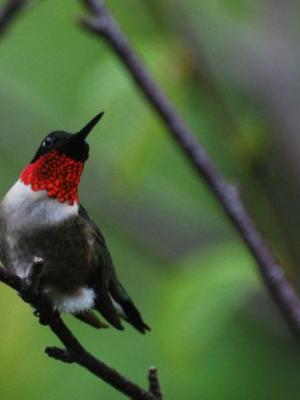
Male Ruby-throated hummingbird. Photo by Kitty Wilson
It never fails to amaze me when the first ruby-throated hummingbird returns to the front porch where we hang a sugar water feeder in late spring. The visitor squeaks, circles, hovers and then approaches my face, making eye contact with his little tilted head before vanishing in a whir and blur of tiny wings.
The message is unmistakable: “Dude, where’s my nectar feeder?”
This tiny bird, small as a mouse, just returned from southern Mexico – a journey of a thousand miles – without the aid of weather forecasts, maps or GPS satellite navigation. During its entire spring migration journey it kept my front porch pillar fixed in it’s innate onboard navigational system as the ultimate destination.
“Recalculating” is necessary when I imagine if I had to make the same trip. The least I can do is offer him sugary cocktail reward!
Migration is amazing! Hundreds of thousands of colorful tropical songbirds have now returned from wintering in Central and South America and the Caribbean islands. On warm southwest winds, they pour into northern forests, farms and suburban backyards to devour the hatching blackflies.

It is no coincidence that New Hampshire is a preferred summer destination for breeding. Northern birds co-evolved timing of the breeding seasons to take advantage of both insect protein and fruit carbohydrates. Their nesting season is closely timed to flower nectar, an explosion of insect protein and the sugary fruits our region provides for raising chicks. It’s worth the hazards of the long migration because insect protein fuels building nests, incubating eggs and feeding vulnerable chicks. Plant carbohydrates from native fruits and berries provide the fuel to form flight feathers fast! Even for birds, New Hampshire is a great place to raise a family!
Ruby-throated Hummingbirds are the only breeding hummingbird in the Northeast. The species occupies the largest breeding range of any North American hummingbird. Ruby-throated Hummingbirds beat their wings 53 times per second. While it is an extremely agile flyer, its short legs prevent it from walking or hopping. Males do not remain with females for long. Breeding pairs remain together for courtship and mating which generally lasts several days to several weeks. Adults begin their fall migration south by early August.
Your backyard was also likely lodged in the navigational memory sector of tropical migrant bird brains. When they arrive, they expect to find summer homes undiminished after such a long journey.
You don’t want to disappoint your winged summer guests! Perhaps we owe them some duty of care and courtesy after they’ve travelled hundreds of miles. That blind faith exhibited by my hummingbird friend creates the responsibility for me to fulfill. He trusts his natal nesting territory awaits him… and maybe even sugar solution in that hanging nectar feeder too!
